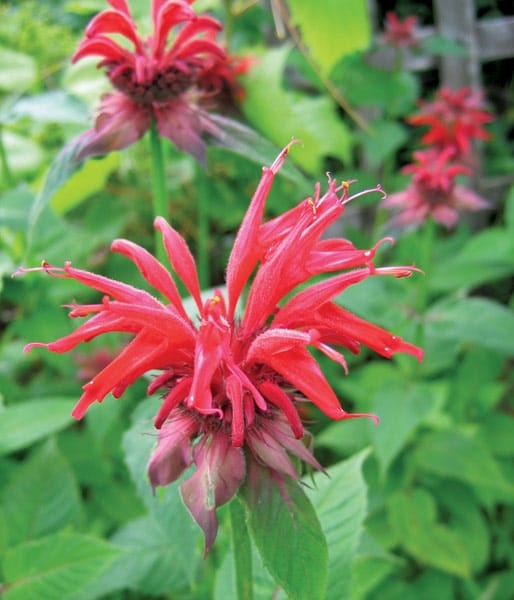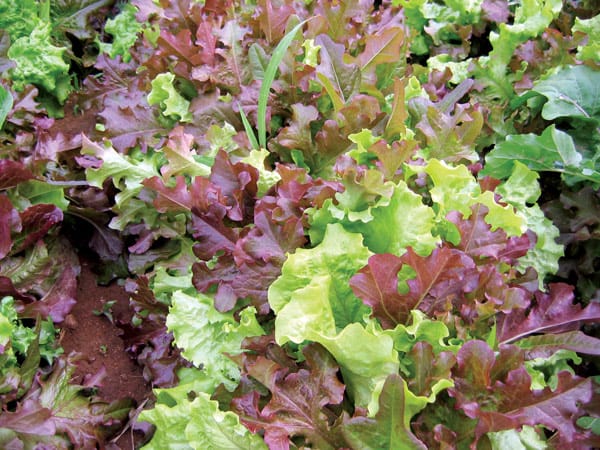Beyond Lettuce Alone
It’s not hard to eat your greens—some in beautiful shades of red, purple and burgundy—when you grow your own.
No one is certain when humans first started enjoying what we know today as salads. We do know that pre-Roman England ate beets and their greens, and that invading Romans brought endive, lettuces and sorrel with them. Somewhere along the way people recognized that after a long winter of eating salted meat and root crops, salad greens were a spring tonic and medicinal corrective.
Although the honeymooner’s salad—lettuce alone—still remains a popular choice as a foundation for great salads, we love to experiment with new tastes, colours and textures. So it’s not surprising that more restaurants and greengrocers are offering exotic salad mixes. Some of the greens we used to cook before serving, such as mustard greens, chards, fennel and beet greens, are now also being enjoyed fresh.
And don’t overlook wild greens that grow in all gardens. Some people refer to them as weeds, but others eagerly seek out and savour early spring dandelion greens, for example, as well as lamb’s quarters, purslane and sorrel. No need to plant these greens—probably you already have more of them than you want, but they also make good compost. The only thing to bear in mind is not to pick wild greens in any area where they may have been sprayed by pesticides, including farm fields, roadsides and your neighbour’s lawn (unless your neighbour is an organic gardener). Most wild greens are best cooked lightly.
The queen of the wild green has to be the fiddlehead, that tightly curled young frond of the ostrich fern, a delectable spring favourite. Ostrich ferns spread by underground stems called rhizomes. It’s possible to transplant a fern or two from the wild and develop a colony, but it takes a few years.

Growing greens in the home garden is usually straightforward. As with most vegetable crops, a loose, well-draining loam is preferable, with an average pH of 6.5, or more or less neutral. The best fertilizer is compost, but you can also amend your soil with seaweed or fish emulsion, bone meal and well-rotted manure. Some gardeners like to plant a cover crop of winter rye or clover the fall before, tilling it in before putting the vegetable garden to bed, to provide a green manure rich in nutrients.
Planting Recommendations
How you plant your salad and cooking greens depends on your space, and the type of garden you prefer. I’ve seen lovely dedicated beds with staggered plantings of various greens, maximizing the number of plants that can flourish in a small area—called intensive gardening—with great results. Some people do artistic things with their salad plantings, creating wonderful quilts of frilled and fringed, speckled and spotted lettuce, mustards and other salad greens. You can plant greens among flowers and herbs, in large containers, or in a standard vegetable or kitchen garden (or potager, as the Acadians would have called it). The main thing to remember is to situate your kitchen garden near your kitchen. You’re much more apt to run outside for a handful of herbs or a colander of greens if it means just ducking out the door, not trekking halfway across the yard.
Many greens are cold hardy and can be planted at the same time as early peas, as soon as the ground is workable in late April/early May. The hardiest include spinach, lettuce, coriander, turnip and mustard greens, then beets, chard, kale and other brassicas, many of which will tolerate a light frost. This cold hardiness comes at a price, however; many of these same greens don’t like the heat of summer, and will bolt or go to seed if not harvested regularly. Yet some of these plants—such as spinach, radicchio, bok choy, endive and lettuce—do nicely when sown later in the summer, eight to 10 weeks before a fall frost generally happens, providing fresh fall greens.
You can start to harvest greens when the leaves are about six inches tall, which can be less than a month from germination. The more they are harvested, the less chance there is of them becoming bitter. Another option is to do successive sowings every two to three weeks throughout the season, providing a constant source of delicately flavoured baby greens for salads.
Cold Frames for Greens
For those who want to extend the seasons, spring or fall, consider using a cold frame—a miniature greenhouse, heated by the sun’s rays. They have several uses, including providing a sheltered site for raising cold-hardy salad vegetables early or late in the season, and for hardening off tender seedlings started indoors before they are planted in the garden in spring.

For the Love of Lettuce
While iceberg has been a long-standing salad staple, and there’s been a huge rise in popularity for romaine over the past decade or so with the demand for a good caesar salad, there’s much more to the lettuce family. Here’s a lineup.
Batavia - Also known as French crisp leaf, it’s considered intermediate, between iceberg and looseleaf types. Many seed companies offer Batavia lettuces, but you’ll seldom see the lettuces for sale at supermarkets. They have a good shelf life and crunchy, sweet leaves that eventually form loose heads, which don’t tend towards bitterness as summer warms up. Look for ‘Cardinale’, a red/green variety; ‘Sierra’, a burgundy tipped green type; and ‘Loma’, a deep green type with frilly leaves.
Butterhead -I’ve always loved the name, even though this type of lettuce doesn’t taste at all buttery. Also called Boston lettuce, butterheads form soft, squishy heads with leaves that are mild tasting and sweet, and make a terrific salad by themselves or as the base for presenting cold seafood, fish and other delights. Cultivars include ‘Buttercrunch’, a faithful standard, ‘Red Butterworth’ a longer-seasoned type, and the lovely ‘Speckled Butterhead’ with bright red speckles and splashes on its tender leaves.
Iceberg or head lettuce - Don’t be too quick to dismiss this type, even if it may seem like a throwback to a time when it was practically all that was available for salads (and only in season). This is one of those cases where the taste is far superior when you grow your own. Look for varieties that aren’t prone to bolting, such as ‘Summertime’ or ‘Tiber’.
Looseleaf - This variety doesn’t form a tight head but is open centred, with lovely loose leaves. ‘Black-seeded Simpson’ is commonly available, but there are lots of other options as well, including those with frilled or lobed leaves in shades of green and wine, some speckled and splashed with contrasting colours. Some to look for include ‘Lolla Rossa’, a frilly dark red type; ‘Vulcan’, a somewhat crinkled and red-green beauty; ‘Red Salad Bowl’, an oakleaf variety.
Romaine or cos - Beloved of caesar salad enthusiasts everywhere, but also terrific in any other type of salad. It’s easily recognized because of its long cylindrical heads and deep green colour, although there are also red varieties available. Remember that the darker the leaves, the more nutritious the lettuce (or any vegetable), regardless of type or variety. Look for ‘Green Forest’, a popular standby; ‘Annapolis’ a dazzlingly red type that doesn’t get bitter; ‘Freckles’, a red-spotted and open variety; and ‘Parris Island Cos’, a big, robust lettuce with pale centres and thick green outer leaves.
Petal Power: Edible Flowers
Want to make your salad even more special? Add some edible flowers from your perennial, annual and herb beds to liven up your plate—and your palate.
By the time the first salad greens are up there will also be violets and Johnny-jump-ups to add some colour and character to the mix. The flowers of herbs such as lavender and sage tend to have a similar but stronger flavour as their leaves, and work well as garnishes and salad-sprucers.
Do not eat flowers that have been sprayed with pesticides. I don’t recommend using flowers from a florist unless it happens to be an organic grower at a local farmer’s market. Likewise, don’t use wildflowers you’ve picked alongside roads or in fields where chemicals might have been used.
For the best flavours, pick blooms just after they’ve opened and as a general rule, eat only the petals, discarding the pistils and stamens in the flowers’ centre.
But don’t take my word for it—here are a few good blossom candidates to sample for yourself:
- Apple
- Bee balm (especially wild bergamot, with deep red flowers)
- Borage
- Calendula
- Chicory
- Chive
- Dandelions
- Daylilies
- Lavender
- Lilacs
- Nasturtiums
- Roses
- Squash and zucchini
- Violets, pansies and Johnny-jump-ups
Marvelous Mesclun
What’s in those mesclun mixes at supermarkets and in seed packets? Varieties vary according to the blends, but here are some of the greens (and reds) you might find included.
Arugula - Considered by many to be the king of gourmet salad greens, although some cultivars tend to be slightly bitter rather than peppery in taste. Arugula is a member of the mustard family and very easy to grow, especially in cool seasons. Keep it well mulched or watered to avoid excessive bitterness.
Bull’s Blood - The greens of Bull’s Blood heirloom beets are actually a deep wine colour, and liven up a salad mix. The beets are edible and tasty when harvested young; plants are sometimes left to mature as ornamentals in a bedding garden.
Corn salad - An unusual, miniature green with a delicately nutty flavour. Known as mache in France, where it’s extremely popular, it’s a hardy and easily grown early vegetable, resistant to bolting and very productive. Because of its diminutive size, corn salad is a good choice for planting between other crops such as peppers and tomatoes.
Mustard greens - This is a catch-all for a number of different types of greens, including various kales, endive, and Chinese greens such as Mizuna and Tatsoi. Known for their distinctive peppery taste, mustard greens are popular in most salad mixes. They’re sometimes plagued by flea beetles, which also bother radishes and other members of the brassica family, but these tend to be less of a problem as the growing season advances.
Radicchio - This popular salad vegetable is closely related to both chicory and the humble dandelion—each of which, incidentally, make fine additions to salads when picked young (and are unsprayed). It’s another robustly flavoured vegetable, and the rich wine and white colour adds splendid zest to salad offerings.
Swiss chard - While not to everyone’s taste in a salad, chard is an easy vegetable to grow and will handle the warmth of the summer months far better than its relative spinach. Try growing ‘Rainbow’, ‘Kaleidoscope’ or ‘Bright Lights’ chard, which boast colourful stems in a number of shades, and are attractive in a mixed border as well as a kitchen garden.
